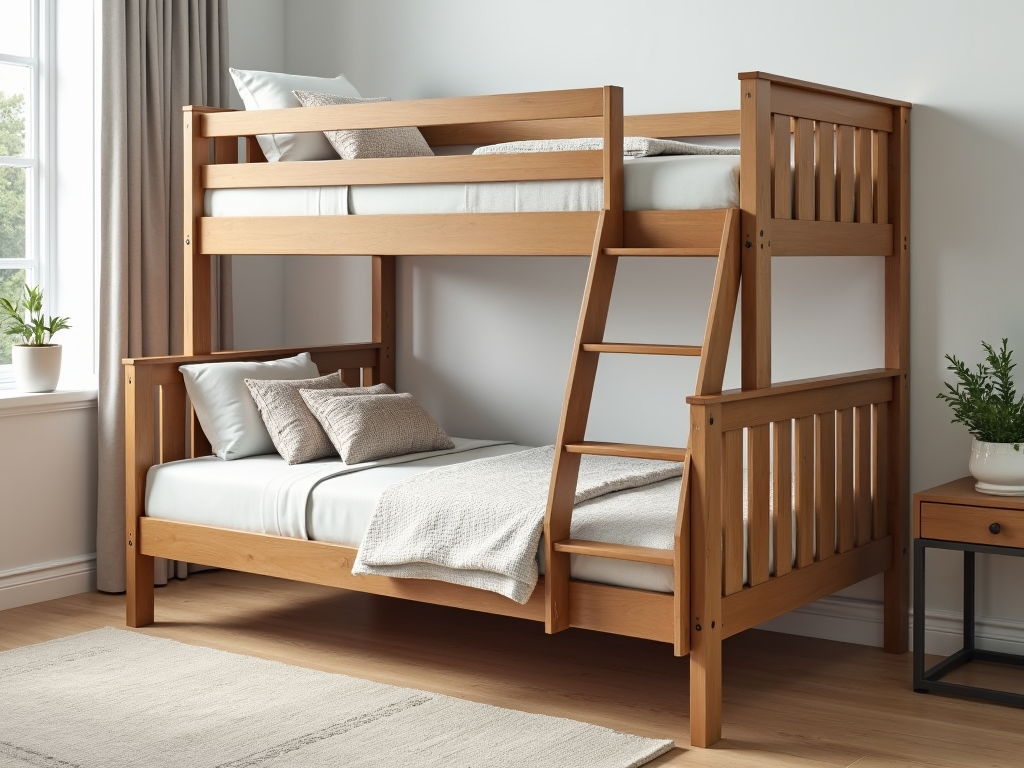Quick facts
Can't find the answer you're looking for? Please get in touch with our friendly team.
Is 8 too old for bunk bed?
No, 8 is not too old for a bunk bed. Many children enjoy bunk beds until they are around 12 or older, depending on their size and comfort. Ensure the bed is sturdy and meets safety standards for older children.
Can I put a 4 year old in a bunk bed?
Yes, you can put a 4-year-old in a bunk bed, but ensure it has safety features like guardrails and a sturdy ladder. It's recommended to place younger children on the bottom bunk to prevent falls. Always supervise their use of the bunk bed.
Is it safe to sleep on a bunk bed?
Yes, it is generally safe to sleep on a bunk bed if it meets safety standards. Ensure the bed has sturdy guardrails, a secure ladder, and is properly assembled. Supervise young children and avoid excessive weight on the top bunk to enhance safety.
Can a 14 year old sleep on a bunk bed?
Yes, a 14-year-old can sleep on a bunk bed, provided it meets safety standards. Ensure the bed has sturdy construction, guardrails, and a proper mattress size. It's also important to consider the child's comfort and preferences when choosing a bunk bed.
Are bunk beds OK for adults?
Yes, bunk beds can be suitable for adults if they are made from sturdy materials and have a high weight capacity. Look for models designed for adult use, ensuring they have proper safety features like guardrails and a secure ladder.
What age is appropriate for bunk beds?
Bunk beds are generally considered appropriate for children aged 6 and older. Kids younger than 6 may be at risk of falling from the top bunk. Always ensure the bed meets safety standards and supervise younger children when using bunk beds.
Category Overview
Introduction
Bunk beds serve as multifunctional furniture pieces that maximize space in homes, particularly in children’s rooms, guest accommodations, or shared spaces. Their primary significance lies in providing a comfortable sleeping solution while enhancing the overall utility and design aesthetics of a room. Whether it’s creating a cozy sleep environment for siblings or accommodating guests without sacrificing floor space, bunk beds are an essential component of modern family living.
Functionality
The core function of bunk beds is to offer two sleeping spaces within the footprint of a single bed, making them ideal for maximizing room efficiency. They are mainly used in bedrooms and can accommodate various needs—from kids hosting sleepovers to providing additional sleeping arrangements in small apartments. Many models feature built-in storage drawers or shelves to further enhance functionality. Some designs even include desks or play areas beneath the upper bunk, allowing for versatile use that adapts to your lifestyle.
Design & Style
Bunk beds come in a variety of styles and materials that cater to different tastes and home decors. Common materials include solid wood, metal frames, and upholstered options, each lending their unique character to the space they occupy. You can find designs ranging from rustic farmhouse styles to sleek modern finishes. Personalizing your bunk bed is easy; you can choose paint colors or bedding sets that align with your overall theme—be it minimalistic, coastal, or whimsical—ensuring that they fit seamlessly into your home decor.
Practical Considerations
When selecting the right bunk bed for your needs, consider room dimensions and ceiling height to ensure ample space above the top bunk. Durability is also key; opt for robust materials if heavy usage is anticipated (think rambunctious kids). Common mistakes include underestimating mattress depth needed for comfort or selecting styles that clash with existing furniture themes. Maximize functionality by choosing models with integrated storage solutions or modular designs that can be adapted as needs change.
Comparison and Alternatives
When choosing between materials like wood or metal for your bunk bed, consider both durability and aesthetic appeal. Wooden bunk beds often provide warmth and classic charm but may require more maintenance than their metal counterparts which tend to be lighter and easier to move around. Round versus rectangular designs can also impact how well they fit into your space; rectangular beds are often more traditional while round options can introduce playful elements into a child’s room.
Trends and Popular Items
Current trends show a rising popularity for eco-friendly materials like sustainably-sourced wood along with contemporary designs featuring clean lines and integrated technology (such as USB charging ports). Additionally, there’s been notable demand for customizable options like lofted beds that allow you to create dedicated study areas below—a clever way to blend functionality with style in smaller homes. In summary, bunk beds are not just about saving space; they're about creating functional areas that enhance everyday life while offering opportunities for personal expression through choice of style and design. Whether you're exploring minimalist options or looking for something bold to contrast an otherwise subdued decor theme, there's a perfect bunk bed waiting out there just for you!


